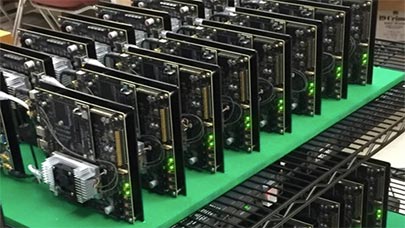
Alternative Supercomputing or How to Misuse a Computer
July 14, 2016
In 2008, the IBM Roadrunner supercomputer broke the petaflops barrier using the power of the heterogeneous Sony Cell Broadband Engine (BE) processor. A year prior, the Cell BE had already made its way into the consumer market as the engine inside the SonyPlaystation 3. The PS3's accelerated design, Linux-capability and low price point... Read more…

Supercomputing’s Golden Age?
April 22, 2013
Compared to overall IT spending, the supercomputing market is quite healthy. Is this the expected evolution of Moore's Law or is it something else entirely? Read more…

Revelations on Roadrunner’s Retirement
April 4, 2013
Following our news report this week on the shuttering of the petaflop pioneer system at Los Alamos National Lab, Roadrunner, we were finally able to snag someone to share on the post-mortem plans for the system, not to mention what some of the considerations were for housing a unique architecture like.... Read more…

Requiem for Roadrunner
April 1, 2013
Over the weekend the IBM Roadrunner, which broke the petascale barrier five years ago, was shuttered in favor of a smaller, more nimble and energy efficient at Los Alamos--Cielo. Before it is dismantled and given a full OS, memory and routing autopsy by LANL researchers, we thought it would be a good time to look back... Read more…

Sony Removes Folding@home Service from PS3
October 22, 2012
After a successful five-year run, Sony is ending its participation with Stanford University's Folding@home project. Read more…

LANL Update: Supers Taken Offline
June 30, 2011
Roadrunner and Cielo have been taken offline due to the excessive smoke and lingering fire threat at Los Alamos National Lab. Read more…

Will Roadrunner Be the Cell’s Last Hurrah?
October 27, 2009
The Roadrunner supercomputer at Los Alamos National Lab employed a hybrid Cell-Opteron architecture to be the first system to reach the petaflop milestone. But with the meteoric rise of more powerful general-purpose GPUs, the prospects for more Cell-based supercomputing may be dimming. Read more…

- Click Here for More Headlines

Whitepaper
Transforming Industrial and Automotive Manufacturing
In this era, expansion in digital infrastructure capacity is inevitable. Parallel to this, climate change consciousness is also rising, making sustainability a mandatory part of the organization’s functioning. As computing workloads such as AI and HPC continue to surge, so does the energy consumption, posing environmental woes. IT departments within organizations have a crucial role in combating this challenge. They can significantly drive sustainable practices by influencing newer technologies and process adoption that aid in mitigating the effects of climate change.
While buying more sustainable IT solutions is an option, partnering with IT solutions providers, such and Lenovo and Intel, who are committed to sustainability and aiding customers in executing sustainability strategies is likely to be more impactful.
Learn how Lenovo and Intel, through their partnership, are strongly positioned to address this need with their innovations driving energy efficiency and environmental stewardship.
Download Now
Sponsored by Lenovo
Whitepaper
How Direct Liquid Cooling Improves Data Center Energy Efficiency
Data centers are experiencing increasing power consumption, space constraints and cooling demands due to the unprecedented computing power required by today’s chips and servers. HVAC cooling systems consume approximately 40% of a data center’s electricity. These systems traditionally use air conditioning, air handling and fans to cool the data center facility and IT equipment, ultimately resulting in high energy consumption and high carbon emissions. Data centers are moving to direct liquid cooled (DLC) systems to improve cooling efficiency thus lowering their PUE, operating expenses (OPEX) and carbon footprint.
This paper describes how CoolIT Systems (CoolIT) meets the need for improved energy efficiency in data centers and includes case studies that show how CoolIT’s DLC solutions improve energy efficiency, increase rack density, lower OPEX, and enable sustainability programs. CoolIT is the global market and innovation leader in scalable DLC solutions for the world’s most demanding computing environments. CoolIT’s end-to-end solutions meet the rising demand in cooling and the rising demand for energy efficiency.
Download Now
Sponsored by CoolIT
Advanced Scale Career Development & Workforce Enhancement Center
Featured Advanced Scale Jobs:
HPCwire Resource Library
HPCwire Product Showcase
© 2024 HPCwire. All Rights Reserved. A Tabor Communications Publication
HPCwire is a registered trademark of Tabor Communications, Inc. Use of this site is governed by our Terms of Use and Privacy Policy.
Reproduction in whole or in part in any form or medium without express written permission of Tabor Communications, Inc. is prohibited.
























